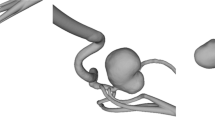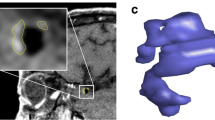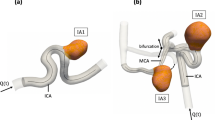Abstract
Aneurysm wall permeability has recently emerged as an in vivo marker of aneurysm wall remodeling. We sought to study the spatial relationship between hemodynamic forces derived from 4D-flow MRI and aneurysm wall permeability by DCE-MRI in a region-based analysis of unruptured saccular intracranial aneurysms (IAs). We performed 4D-flow MRI and DCE-MRI on patients with unruptured IAs of ≥ 5 mm to measure hemodynamic parameters, including wall shear stress (WSS), oscillatory shear index (OSI), WSS temporal (WSSGt) and spatial (WSSGs) gradient, and aneurysm wall permeability (Ktrans) in different sectors of aneurysm wall defined by evenly distributed radial lines emitted from the aneurysm center. The spatial association between Ktrans and hemodynamic parameters measured at the sector level was evaluated. Thirty-one patients were scanned. Ktrans not only varied between aneurysms but also demonstrated spatial heterogeneity within an aneurysm. Among all 159 sectors, higher Ktrans was associated with lower WSS, which was seen in both Spearman’s correlation analysis (rho = − 0.18, p = 0.025) and linear regression analysis using generalized estimating equation to account for correlations between multiple sectors of the same aneurysm (regression coefficient = − 0.33, p = 0.006). Aneurysm wall permeability by DCE-MRI was shown to be spatially heterogenous in unruptured saccular IAs and associated with local WSS by 4D-flow MRI.

Similar content being viewed by others
Data availability
The data from this study are available from the corresponding author upon reasonable request.
References
Kadasi LM, Dent WC, Malek AM (2013) Colocalization of thin-walled dome regions with low hemodynamic wall shear stress in unruptured cerebral aneurysms. J Neurosurg 119:172–179. https://doi.org/10.3171/2013.2.jns12968
Cebral J, Ollikainen E, Chung BJ, Mut F, Sippola V, Jahromi BR, Tulamo R, Hernesniemi J, Niemelä M, Robertson A et al (2017) Flow conditions in the intracranial aneurysm lumen are associated with inflammation and degenerative changes of the aneurysm wall. Am J Neuroradiol 38:119–126. https://doi.org/10.3174/ajnr.A4951
Brinjikji W, Chung BJ, Jimenez C, Putman C, Kallmes DF, Cebral JR (2017) Hemodynamic differences between unstable and stable unruptured aneurysms independent of size and location: a pilot study. J Neurointerv Surg 9:376–380. https://doi.org/10.1136/neurintsurg-2016-012327
Cebral JR, Detmer F, Chung BJ, Choque-Velasquez J, Rezai B, Lehto H, Tulamo R, Hernesniemi J, Niemela M, Yu A et al (2019) Local hemodynamic conditions associated with focal changes in the intracranial aneurysm wall. AJNR Am J Neuroradiol 40:510–516. https://doi.org/10.3174/ajnr.A5970
van Ooij P, Potters WV, Guedon A, Schneiders JJ, Marquering HA, Majoie CB, vanBavel E, Nederveen AJ (2013) Wall shear stress estimated with phase contrast MRI in an in vitro and in vivo intracranial aneurysm. J Magn Reson Imaging JMRI 38:876–884. https://doi.org/10.1002/jmri.24051
Schnell S, Ansari SA, Vakil P, Wasielewski M, Carr ML, Hurley MC, Bendok BR, Batjer H, Carroll TJ, Carr J et al (2014) Three-dimensional hemodynamics in intracranial aneurysms: influence of size and morphology. J Magn Reson Imaging JMRI 39:120–131. https://doi.org/10.1002/jmri.24110
Vakil P, Ansari SA, Cantrell CG, Eddleman CS, Dehkordi FH, Vranic J, Hurley MC, Batjer HH, Bendok BR, Carroll TJ (2015) Quantifying intracranial aneurysm wall permeability for risk assessment using dynamic contrast-enhanced MRI: a pilot study. AJNR Am J Neuroradiol 36:953–959. https://doi.org/10.3174/ajnr.A4225
Qi H, Liu X, Liu P, Yuan W, Liu A, Jiang Y, Li Y, Sun J, Chen H (2019) Complementary roles of dynamic contrast-enhanced MR imaging and postcontrast vessel wall imaging in detecting high-risk intracranial aneurysms. Am J Neuroradiol 40:490–496. https://doi.org/10.3174/ajnr.A5983
Wetzel S, Meckel S, Frydrychowicz A, Bonati L, Radue EW, Scheffler K, Hennig J, Markl M (2007) In vivo assessment and visualization of intracranial arterial hemodynamics with flow-sensitized 4D MR imaging at 3T. AJNR Am J Neuroradiol 28:433–438
Tofts PS, Brix G, Buckley DL, Evelhoch JL, Henderson E, Knopp MV, Larsson HB, Lee TY, Mayr NA, Parker GJ et al (1999) Estimating kinetic parameters from dynamic contrast-enhanced T(1)-weighted MRI of a diffusable tracer: standardized quantities and symbols. J Magn Reson Imaging JMRI 10:223–232. https://doi.org/10.1002/(sici)1522-2586(199909)10:3%3c223::aid-jmri2%3e3.0.co;2-s
Stalder AF, Russe MF, Frydrychowicz A, Bock J, Hennig J, Markl M (2008) Quantitative 2D and 3D phase contrast MRI: optimized analysis of blood flow and vessel wall parameters. Magn Reson Med 60:1218–1231. https://doi.org/10.1002/mrm.21778
Xiang J, Natarajan SK, Tremmel M, Ma D, Mocco J, Hopkins LN, Siddiqui AH, Levy EI, Meng H (2011) Hemodynamic-morphologic discriminants for intracranial aneurysm rupture. Stroke 42:144–152. https://doi.org/10.1161/strokeaha.110.592923
Cebral JR, Mut F, Weir J, Putman CM (2011) Association of hemodynamic characteristics and cerebral aneurysm rupture. AJNR Am J Neuroradiol 32:264–270. https://doi.org/10.3174/ajnr.A2274
Miura Y, Ishida F, Umeda Y, Tanemura H, Suzuki H, Matsushima S, Shimosaka S, Taki W (2013) Low wall shear stress is independently associated with the rupture status of middle cerebral artery aneurysms. Stroke 44:519–521. https://doi.org/10.1161/strokeaha.112.675306
Zhou G, Zhu Y, Yin Y, Su M, Li M (2017) Association of wall shear stress with intracranial aneurysm rupture: systematic review and meta-analysis. Sci Rep. https://doi.org/10.1038/s41598-017-05886-w
Xiao W, Qi T, He S, Li Z, Ou S, Zhang G, Liu X, Huang Z, Liang F (2018) Low wall shear stress is associated with local aneurysm wall enhancement on high-resolution MR vessel wall imaging. AJNR Am J Neuroradiol 39:2082–2087. https://doi.org/10.3174/ajnr.A5806
Khan MO, Toro Arana V, Rubbert C, Cornelius JF, Fischer I, Bostelmann R, Mijderwijk HJ, Turowski B, Steiger HJ, May R et al (2020) Association between aneurysm hemodynamics and wall enhancement on 3D vessel wall MRI. J Neurosurg. https://doi.org/10.3171/2019.10.jns191251
Hadad S, Mut F, Chung BJ, Roa JA, Robertson AM, Hasan DM, Samaniego EA, Cebral JR (2021) Regional aneurysm wall enhancement is affected by local hemodynamics: a 7T MRI study. AJNR Am J Neuroradiol 42:464–470. https://doi.org/10.3174/ajnr.A6927
Funding
This study was supported by the National Key Research & Development (R&D) Program of China (2017YFC0108702), the National Natural Science Foundation of China (81371540, 81771233, 81901197, and 81930119), the Beijing Municipal Natural Science Foundation (Z190024), and the Specific Research Projects for Capital Health Development (no. 2018-2-2041).
Author information
Authors and Affiliations
Contributions
Study concept and design, all authors; acquisition of data, YW, RL, PL, JJ, CC, HQ, LZ, LJ, FP, MX, CK, SX, LH; analysis and interpretation of data, YW, JS, PL, XL, YC, HQ, YL, MF, YW, XW, QZ, ZC; drafting of the manuscript, YW, JS, HC; critical revision of the manuscript for important intellectual content, all authors; statistical analysis, YW, JS; obtained funding, PL, AL, HC; study supervision, YL, ML, HC; responsible for the overall content as guarantor, ML, HC.
Corresponding authors
Ethics declarations
Conflicts of interest
The authors declare that they have no conflict of interest.
Ethical approval
This study was approved by the local Institutional Review Board.
Consent to participate
All participants provided written informed consent.
Supplementary Information
Below is the link to the electronic supplementary material.
Rights and permissions
About this article
Cite this article
Wang, Y., Sun, J., Li, R. et al. Increased aneurysm wall permeability colocalized with low wall shear stress in unruptured saccular intracranial aneurysm. J Neurol 269, 2715–2719 (2022). https://doi.org/10.1007/s00415-021-10869-z
Received:
Revised:
Accepted:
Published:
Issue Date:
DOI: https://doi.org/10.1007/s00415-021-10869-z




